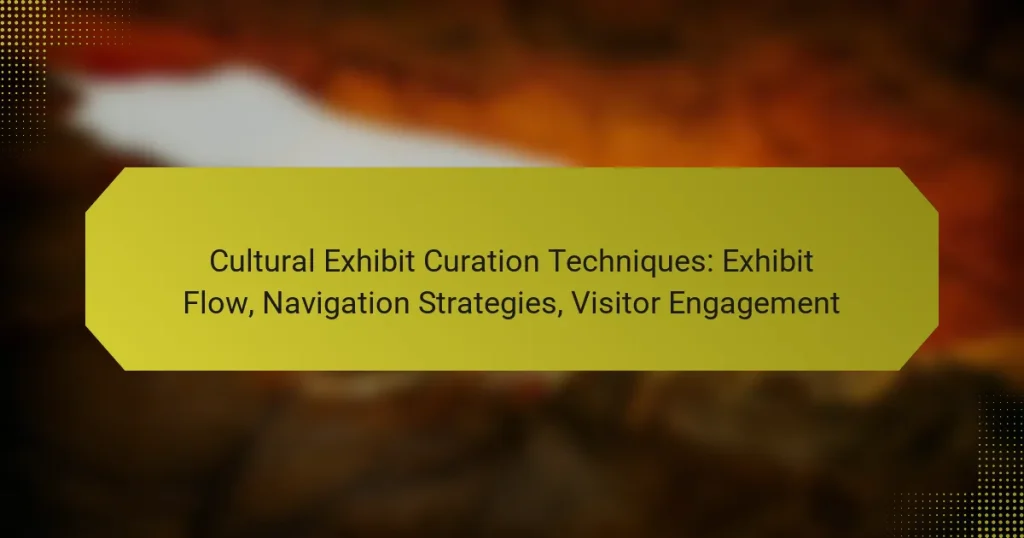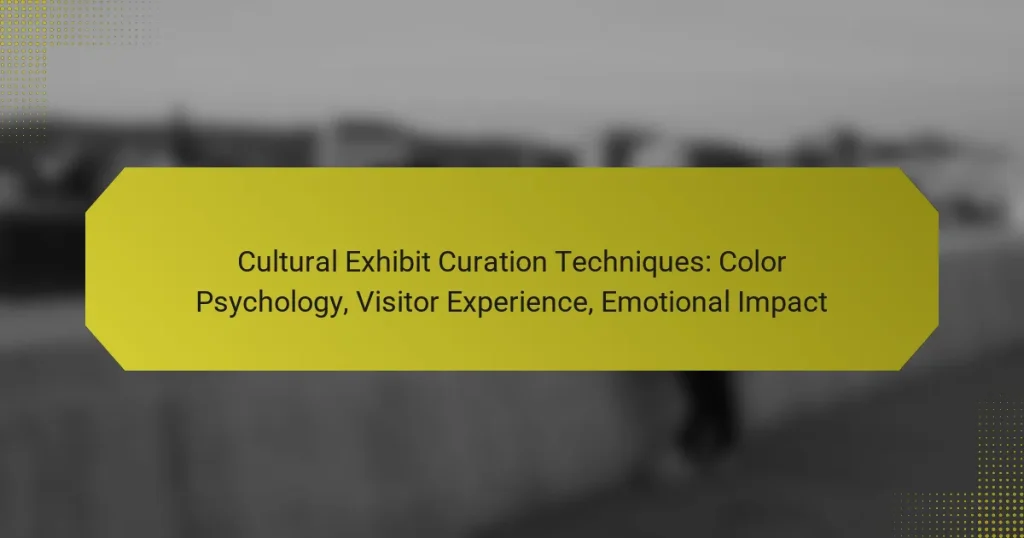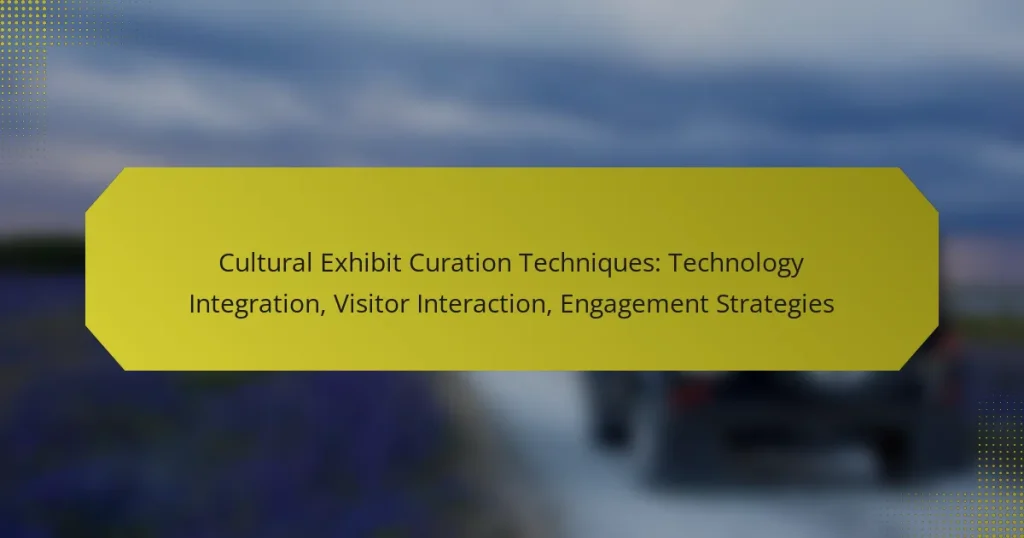Designing effective cultural exhibits requires a thoughtful approach that prioritizes interactivity, local craftsmanship, and compelling narratives. By incorporating key principles such as accessibility and clear visual hierarchy, these exhibits can enhance visitor experiences and foster a deeper understanding of diverse cultures. Additionally, leveraging technologies like augmented reality and digital signage can create immersive environments that engage audiences and convey complex information effectively.
Cultural Exhibit Curation Techniques: Color Psychology, Visitor Experience, Emotional Impact
Cultural Exhibit Curation Techniques: Technology Integration, Visitor Interaction, Engagement Strategies
Cultural Exhibit Curation Techniques: Accessibility Features, Visitor Experience, Flow and Navigation, Aesthetics and Functionality
Cultural Exhibit Curation Techniques: Case Studies, Successful Designs, Museum Exhibits
Cultural Exhibit Curation Techniques: Aesthetics, Functionality, Layout Optimization
Cultural Exhibit Curation Techniques: Lighting Impact, Perception, Visitor Engagement
How to Create Engaging Cultural Exhibits in Major Cities?
To create engaging cultural exhibits in major cities, focus on interactivity, local craftsmanship, and compelling narratives. These elements not only attract visitors but also foster a deeper understanding of the culture being represented.
Incorporate Interactive Elements
Interactive elements enhance visitor engagement by allowing them to participate actively in the exhibit. Consider incorporating touchscreens, virtual reality experiences, or hands-on displays that encourage exploration and learning.
For example, an exhibit on local history might include a digital timeline where visitors can select different eras to learn about significant events. This approach caters to diverse learning styles and keeps visitors interested.
Utilize Local Artisans
Involving local artisans in your cultural exhibit can provide authenticity and support the community. Collaborate with craftspeople to showcase traditional techniques and create live demonstrations that highlight their skills.
For instance, a cultural exhibit could feature a local potter creating pieces on-site, allowing visitors to appreciate the craftsmanship and even purchase unique items. This not only enriches the exhibit but also stimulates the local economy.
Focus on Storytelling Techniques
Effective storytelling is crucial for conveying the significance of cultural exhibits. Use narratives that resonate with visitors, incorporating personal stories, historical context, and emotional connections to the culture.
Consider using multimedia presentations, guided tours, or audio guides that narrate the stories behind the artifacts. This approach can transform a simple display into a memorable experience, encouraging visitors to reflect on what they’ve learned.
What Design Principles Enhance Visitor Experience?
Effective design principles enhance visitor experience by creating engaging, informative, and accessible cultural exhibits. Key elements include ensuring accessibility, establishing a clear visual hierarchy, and facilitating smooth visitor flow throughout the space.
Accessibility and Inclusivity
Accessibility and inclusivity are essential for ensuring that all visitors can engage with cultural exhibits. This includes providing features such as ramps, tactile elements, and audio descriptions for individuals with disabilities.
Consider implementing universal design principles, which cater to a diverse audience. For example, using large print signage and contrasting colors can help visually impaired visitors navigate the exhibit more easily.
Regularly assess your exhibit for compliance with local accessibility standards, such as the Americans with Disabilities Act (ADA) in the United States or similar regulations in other countries. This not only enhances visitor experience but also demonstrates a commitment to inclusivity.
Visual Hierarchy and Flow
Visual hierarchy and flow guide visitors through the exhibit in a logical manner, enhancing their understanding and engagement. Use size, color, and placement to emphasize key information and create a natural path for exploration.
For instance, larger text and bold images can draw attention to important displays, while arrows or lines on the floor can direct foot traffic. This helps prevent congestion and allows visitors to absorb information at their own pace.
Evaluate the layout regularly to ensure it meets visitor needs. Conducting visitor surveys can provide insights into how well the flow works and identify areas for improvement. Aim for a balance between aesthetic appeal and functional design to create a memorable experience.
Which Technologies Improve Cultural Exhibit Design?
Technologies such as augmented reality and digital signage significantly enhance cultural exhibit design by creating immersive and interactive experiences for visitors. These tools engage audiences more effectively and can convey complex information in an accessible manner.
Augmented Reality Applications
Augmented reality (AR) applications overlay digital content onto the physical world, allowing visitors to interact with exhibits in innovative ways. For example, an AR app might enable users to view historical artifacts in 3D or see reconstructions of ancient sites through their smartphones or tablets.
When implementing AR, consider the user experience and ensure that the technology is intuitive. Common pitfalls include overly complex interfaces and technical issues that can frustrate users. Aim for simplicity and provide clear instructions to enhance engagement.
Digital Signage Solutions
Digital signage solutions use screens to display dynamic content, such as videos, images, and information about exhibits. This technology can adapt in real-time to audience preferences and can be updated remotely, making it a flexible option for cultural institutions.
When choosing digital signage, consider factors like screen size, resolution, and placement to maximize visibility and impact. It’s essential to ensure that the content is relevant and updated regularly to keep visitors informed and engaged. Avoid cluttered designs that can overwhelm viewers; instead, focus on clear, concise messaging.
What Are the Key Considerations for Cultural Sensitivity?
Cultural sensitivity involves understanding and respecting the diverse backgrounds and values of different communities. Key considerations include awareness of cultural norms, avoiding stereotypes, and engaging with community members to ensure authentic representation.
Community Engagement Practices
Effective cultural exhibits rely heavily on community engagement practices. Involve local stakeholders from the planning stage to gather insights and feedback, ensuring the exhibit resonates with the community’s values and narratives. Regular meetings and workshops can facilitate open dialogue and foster trust.
Utilize various engagement methods, such as surveys, focus groups, and public forums, to reach a broad audience. Consider using social media platforms to engage younger demographics and gather diverse perspectives.
Research Local Histories
Thorough research of local histories is crucial for creating culturally sensitive exhibits. Understand the historical context, significant events, and influential figures relevant to the community. This knowledge helps in accurately representing their stories and experiences.
Consult local historians, cultural organizations, and academic resources to gather comprehensive information. Additionally, consider incorporating oral histories from community members to provide personal insights and enrich the narrative.
How to Measure the Success of Cultural Exhibits?
Measuring the success of cultural exhibits involves evaluating visitor engagement, satisfaction, and educational impact. Key metrics include attendance numbers, visitor feedback, and the effectiveness of educational programs.
Visitor Feedback Mechanisms
Visitor feedback mechanisms are essential for understanding audience perceptions and experiences. Common methods include surveys, comment cards, and interactive kiosks that allow guests to provide real-time input. Ensuring anonymity can encourage more honest and constructive feedback.
Consider using a mix of quantitative and qualitative questions to capture a broad range of insights. For instance, ask visitors to rate their experience on a scale from 1 to 10, while also providing space for open-ended comments. This dual approach can yield actionable data.
Data Analytics Tools
Data analytics tools help cultural institutions analyze visitor data effectively. These tools can track attendance patterns, demographic information, and engagement levels through digital platforms. Utilizing software like Google Analytics or specialized museum management systems can provide valuable insights.
When selecting analytics tools, consider their ability to integrate with existing systems and their user-friendliness. Regularly reviewing analytics reports can help identify trends and inform future exhibit planning, ensuring that cultural exhibits remain relevant and engaging for diverse audiences.
What Are the Future Trends in Cultural Exhibit Design?
Future trends in cultural exhibit design focus on sustainability, technology integration, and audience engagement. These trends aim to create immersive experiences while minimizing environmental impact and enhancing accessibility.
Sustainability Practices
Sustainability practices in cultural exhibit design prioritize eco-friendly materials and energy-efficient technologies. Designers are increasingly using recycled or locally sourced materials to reduce carbon footprints and support local economies.
Incorporating renewable energy sources, such as solar panels, can further enhance sustainability. Additionally, designing exhibits that require minimal energy for lighting and climate control is essential for long-term environmental responsibility.
Integration of Virtual Experiences
Integrating virtual experiences into cultural exhibits allows for enhanced visitor engagement and accessibility. Technologies like augmented reality (AR) and virtual reality (VR) can provide immersive storytelling that complements physical displays.
Exhibits can offer virtual tours or interactive elements that cater to diverse audiences, including those unable to visit in person. It’s crucial to ensure that these technologies are user-friendly and seamlessly integrated to maintain the overall exhibit experience.






